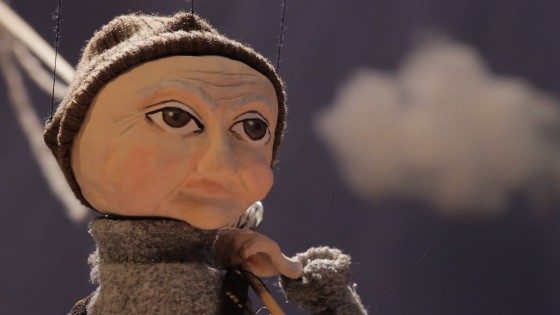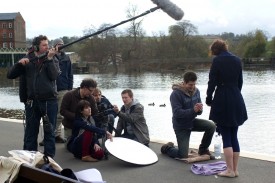Throughout September I got a crash-course introduction to the Blackmagic Cinema Camera as I used it to shoot Harriet Sams’ period action adventure web series The First Musketeer. The camera was kindly lent to us by our gaffer, Richard Roberts. Part-way through the shoot I recorded my initial thoughts on the camera in this video blog:
Here’s a summary of the key differences between the Blackmagic and a Canon DSLR.
| Canon DSLR | Blackmagic Cinema Camera |
| Rolling shutter (causes picture distortion during fast movement) | Rolling shutter (though not as bad as DSLRs) |
| Pixels thrown away to achieve downscaling to 1080P video resolution, results in distracting moiré patterns on fabrics, bricks walls and other grid-like patterns | Pixels smoothly downscaled from 2.5K to 1080P to eliminate moiré. Raw 2.5K recording also available |
| On-board screen shuts off when external monitor is connected | On-board screen remains on when external monitor is connected |
| Some models have flip-out screens which can be adjusted to any viewing angle and easily converted into viewfinders with a cheap loupe attachment | On-board screen is fixed and highly reflective so hard to see in all but the darkest of environments |
| Maximum frame rate: 60fps at 720P | Maximum frame rate: 30fps at 1080P |
| 50mm lens is equivalent to 50mm (5D) or 72mm (other models) full-frame lens | 50mm lens is equivalent to 115mm full-frame lens |
| 10-11 stops of dynamic range | 13 stops of dynamic range |
| Recording format: highly compressed H.264, although Magic Lantern now allows for limited raw recording | Recording format: uncompressed raw, ProRes or DNXHD |
| Battery life: about 2 hours from the 600D’s bundled battery in movie mode | Battery life: about 1 hour from the non-removable internal battery |
| Weight: 570g (600D) | Weight: 1,700g |
| Audio: stereo minijack input, no headphone socket | Audio: dual quarter-inch jacks for input, headphone socket |
Having now come to the end of the project, I stand by the key message of my video blog above: if you already own a DSLR, it’s not worth upgrading to a Blackmagic. You’d just be swapping one set of problems (rolling shutter, external monitoring difficulties, aliasing) for another (hard-to-see on-board screen, weight, large depth of field).

The depth of field was really the killer for me. Having shot on the 600D for three years I’m used to its lovely shallow depth of field. With the Blackmagic’s smaller 16mm sensor it was much harder to throw backgrounds of focus, particularly on wide shots. At times I felt like some of the material I was shooting looked a bit “TV” as a result.
The small sensor also creates new demands on your set of lenses; they all become more telephoto than they used to be. A 50mm lens used on a crop-chip DSLR like the 600D is equivalent to about an 72mm lens on a full-frame camera like the 5D Mark III or a traditional 35mm SLR. That same 50mm lens used on the Blackmagic is equivalent to 115mm! It was lucky that data wrangler Rob McKenzie was able to lend us his Tokina 11-16mm f2.8 otherwise we would not have been able to get useful wide shots in some of the more cramped locations.
As for the Blackmagic’s ability to shoot raw, it sounds great, but will you use it? I suggest the images you get in ProRes mode are good enough for anything bar a theatrical release, and are of a far more manageable data size. You still get the high dynamic range in ProRes mode (although it’s optional), and that takes a little getting used to for everyone. More than once the director asked me to make stuff moodier, more shadowy; the answer was it is shadowy, you just won’t be able to see it like that until it’s graded.
The colour saturation is also very low, again to give maximum flexibility in the grade, but it makes it very hard for the crew huddled around the monitor to get a sense of what the finished thing is going to look like. As a cinematographer I pride myself on delivering images that looked graded before they actually are, but I couldn’t do that with the Blackmagic. But maybe that’s just a different workflow I’d need to adapt to.
The biggest plus to the BMCC is the lovely organic images it produces, as a result of both the down-sampling from 2.5K and the high dynamic range. This was well suited to The First Musketeer’s period setting. However, I think next season I’ll be pushing for a Canon C300 to get back the depth of field.
I’ll leave you with a few frame grabs from The First Musketeer.
Note: I have amended this post as I originally stated, incorrectly, that the BMCC has a global shutter. The new 4K Blackmagic Production Camera does have a global shutter though.





